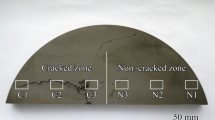Abstract
2D finite element analysis was conducted on the temperature field to create an amorphous ingot by vacuum water quenching. An optimized analysis document was then written by ANSYS parametric design language, and the optimal design modules of ANSYS were used to study the inside diameter and wall thickness of the quartz tube, as well as the water temperature. The microstructure and the phase structure of the amorphous ingot were evaluated by scanning electron microscopy and X-ray diffraction, respectively. Results show that during the cooling process, the thinner wall thickness, smaller diameter of the ingot, or lower temperature of the water environment can result in higher cooling rate at a given temperature. Besides, the gap between the different cooling rates induced by wall thickness or diameter of the ingot narrows down as the temperature decreases, and the gap between the different cooling rates induced by temperature of the water environment remains constant. The process parameters in creating an amorphous ingot, which is optimized by the finite element analysis on the temperature field, are reliable.







Similar content being viewed by others
References
A. Inoue: Acta Mater., 2000, vol. 48, pp. 279-306.
H.B. Fan, W. Zheng, G.Y. Wang, P.K. Liaw, and J. Shen: Metall. Mater. Trans. A, 2011, vol. 42A, pp. 1524-33.
X.J. Gu, S.J. Poon, G.J. Shiflet, and M. Widom: Acta Mater., 2008, vol. 56, pp. 88-94.
F.S. Li, B. Shen, A. Makino, and A. Inoue: Appl. Phys. Lett., 2007, vol. 91, p. 234101.
J.E. Gao, H.X. Li, Z.B. Jiao, Y. Wu, Y.H. Chen, T. Yu, and Z.P. Lu: Appl. Phys. Lett., 2011, vol. 99, p. 052504.
A. Inoue: Mater. Trans. JIM, 1995, vol. 36, pp. 866-75.
I. Akihisa, K. Kazuhiko, and Z. Tao: Mater. Trans. JIM, 1989, vol. 30, pp. 722-25.
A.D. Setyawan, H. Kato, J. Saida, and A. Inoue: J. Appl. Phys., 2008, vol. 103, p. 044907.
A.D. Setyawan, H. Kato, J. Saida, and A. Inoue: Phil. Mag., 2008, vol. 88, pp. 1125-36.
A. Peker, and W.L. Johnson: Appl. Phys. Lett., 1993, vol. 63, pp. 2342-44.
W. Zhao, G. Li, Y.Y. Wang, and R.P. Liu: J. Non-Cryst. Solids, 2012, vol. 358, pp. 3318-21.
W.H. Wang: J. Appl. Phys., 2011, vol. 110, p. 053521.
Acknowledgments
The current study was supported by the National Basical Research Program of China (Grant No. 2010CB731600) and National Science Foundation of China (Grant No. 51271161/51121061/51171163).
Author information
Authors and Affiliations
Corresponding author
Additional information
Manuscript submitted April 25, 2013.
Rights and permissions
About this article
Cite this article
Zhao, W., Sun, Z., Tang, Z. et al. ANSYS-Based Simulation and Optimization on Temperature Field of Amorphous Ingot Made by Water Quenching. Metall Mater Trans A 45, 2371–2375 (2014). https://doi.org/10.1007/s11661-013-1838-0
Published:
Issue Date:
DOI: https://doi.org/10.1007/s11661-013-1838-0




